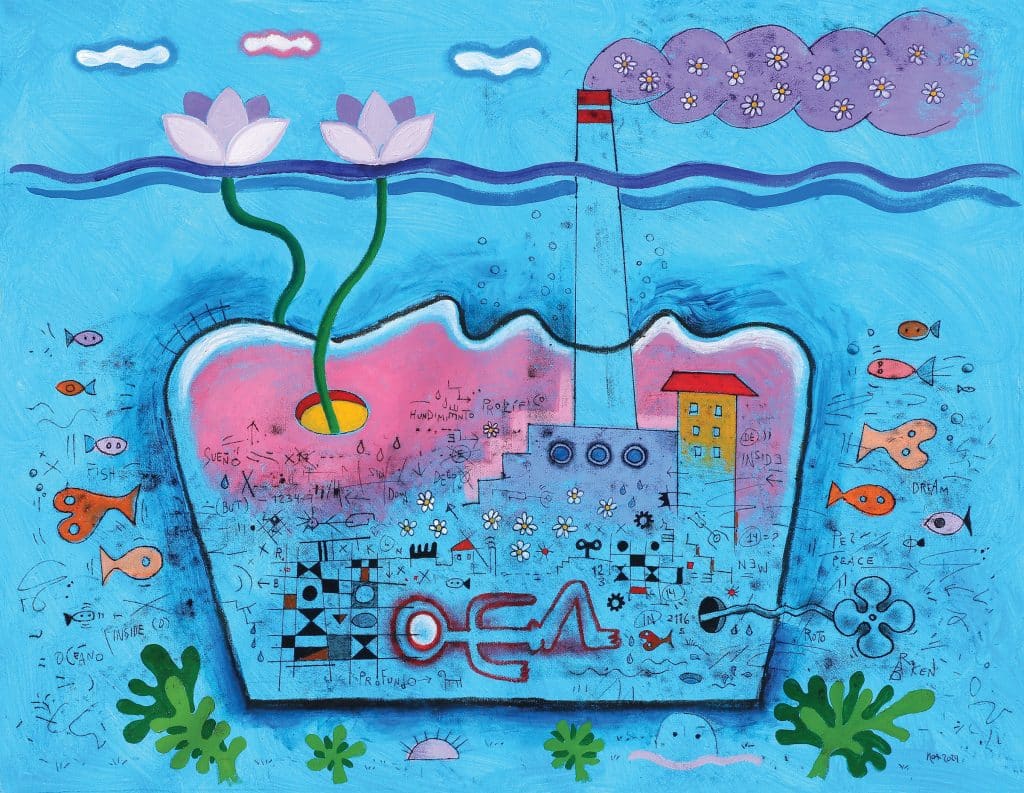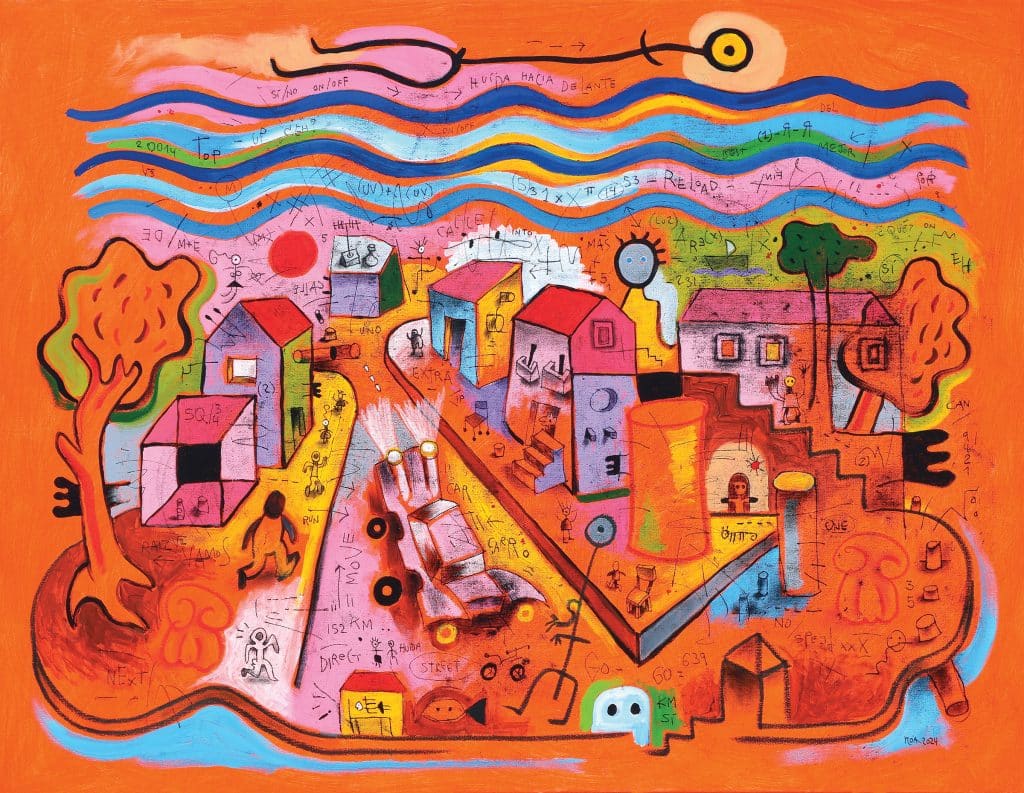Fallen Idol (2024, mixed media, 102×102 cm)
by Rebecca M. Alvin
Luis Rodriguez, better known by his maternal surname Noa, is a Havana-based artist whose works combine elements of street art and surrealism with a distinct visual language reminiscent of ancient pictographic languages, such as Egyptian or Mayan hieroglyphics. Combined with bright colors and often set within an urban Cuban landscape, their meaning and substance are conveyed through the viewer’s active engagement with these symbols and flat-perspective layers, with clues in the actual words scratched on the canvas—in both English and Spanish—throughout many of the paintings.
In many cases these are paintings that invite continual reflection as they are imbued with meanings that can only become clear after spending time with the works. For example, Fallen Idol, with its various scenes of violence and references to death alternating with a joyful carnival ride within a larger structure that looks like a living house invites interpretation around a central theme of dying. In other cases, the imagery is more direct such as Espacio Emocional where the idea of being constricted and constrained is evident.
“I tend to philosophize a lot. I tend to be too deep sometimes. And I had paintings some years ago in oil on canvas that were like that—very symbolic, very deep,” he says, reflecting on his past work. “And then I realized that I had to tell other things and I couldn’t do it like that. For me, it was a good thing to find a combination between poetry, philosophy, and everyday life. I needed that balance of poetry, symbol, philosophy, which is sometimes like more encrypted, and then you have things from everyday life that you can use as a medium to transmit or bring meaning to the people. And then it will act as an intermediary and make the painting less encrypted. So it’s a mix of things. The contrast, I also like, between chaos and order.”

When his father died two years ago, it initiated a difficult period for Noa, personally. “It shocked me a lot. It put me really in a bad situation,” he recalls. “And then I had some personal issues here at home. And also the country’s changing, and I needed to grow over all these situations to start working [again], because I was, like, stopping painting for a while. It was, like, more than a year without making any thing, like not a single drawing.”
Today, he says he misses the conversations he would have with his father, who was also an artist and Noa’s first art teacher. But Noa came to a realization that he needed to work these themes of loss and transformation into his work and infuse the paintings with a new energy, the kind of internal shifts that only come through traumatic and difficult experiences. These are the works that will be on view at Galeria Cubana in Provincetown this week in a show called Punto de Inflexión or Turning Point. They demonstrate his realization that he had to grow as an artist to face not only his personal struggles, but also the changing times in Cuba. “I said that this is the moment of a transformation,” he explains. “I suddenly had the feeling… that I have to work toward these situations, and I entitled my exhibition ‘Turning Point’ because it’s what I feel.”

The new work is about exploring new things, for Noa. “Not like abandoning what I had already, but giving it a new space. Like a new life, like a new approach, a new angle, making me grow. Somehow all these situations, all these problems, provoked me to, to push me a little bit more and to grow emotionally to abandon my comfort zone,” he explains. “I was somehow comfortable with what I was doing and comfortable with the point I had reached already. And somehow I was sleeping. And these things, like, woke me up.”
Noa works from his unconscious, connecting him with surrealism as an approach to making art, and as what has been called a natural characteristic of Latin American art. When the European Surrealists came to Latin America in the World War II/Spanish Civil War era, they were unanimously surprised by what they called the intrinsic surrealism of everyday life there—in Mexico and the Caribbean, in particular. They realized that it had existed there much more organically and in isolation from the movement in Europe and elsewhere.
“Here you can find a lot of chaos. This is a very strange country because in many ways, it doesn’t work properly like other countries, which have the things on time, which have things on schedule. Whatever you see working [elsewhere], it doesn’t work like that. We are like a surrealistic place. If you want it or not. You come here and you will see this is a very surrealistic place. By nature. You don’t have to do a lot; you realize it immediately. So for me, it’s like the time here doesn’t work the same way like in other places. It just doesn’t. So you have a mess on one hand, but at the same time, it’s charming because it doesn’t work like in other places. And then you have surprises that you were not expecting” he says with a laugh.

He gives as an example the simple everyday experience of going to buy bread. He went to the counter and the man inside was playing the guitar while someone outside was singing. No one would sell the bread to him until they finished. And after they finished the song, they started another. Noa laughs and says this is normal life in Cuba. “You don’t have to be a ‘Surrealist’ painter, you just have to take a paper and paint to note what is going on outside.”
Noa has also been to Provincetown in the past and enjoys the atmosphere here, which he likens to a carnival. He recalls one trip with his family when the meaning of Bear Week became clear to them as he, his daughter, and his wife walked through the streets and took in the street scenes of that particular week. A different kind of surrealism, one he looks forward to experiencing again this week.
Luis Rodriguez, a.k.a. Noa, will be present at the opening of his new exhibition, La Punto de Inflexión/Turning Point, at Galeria Cubana, 357 Commercial St., Provincetown. The show runs August 1 – 12, and the opening reception will be Friday, August 2, at 6 p.m. For more information call 508.487.2822 or visit lagaleriacubana.com.











